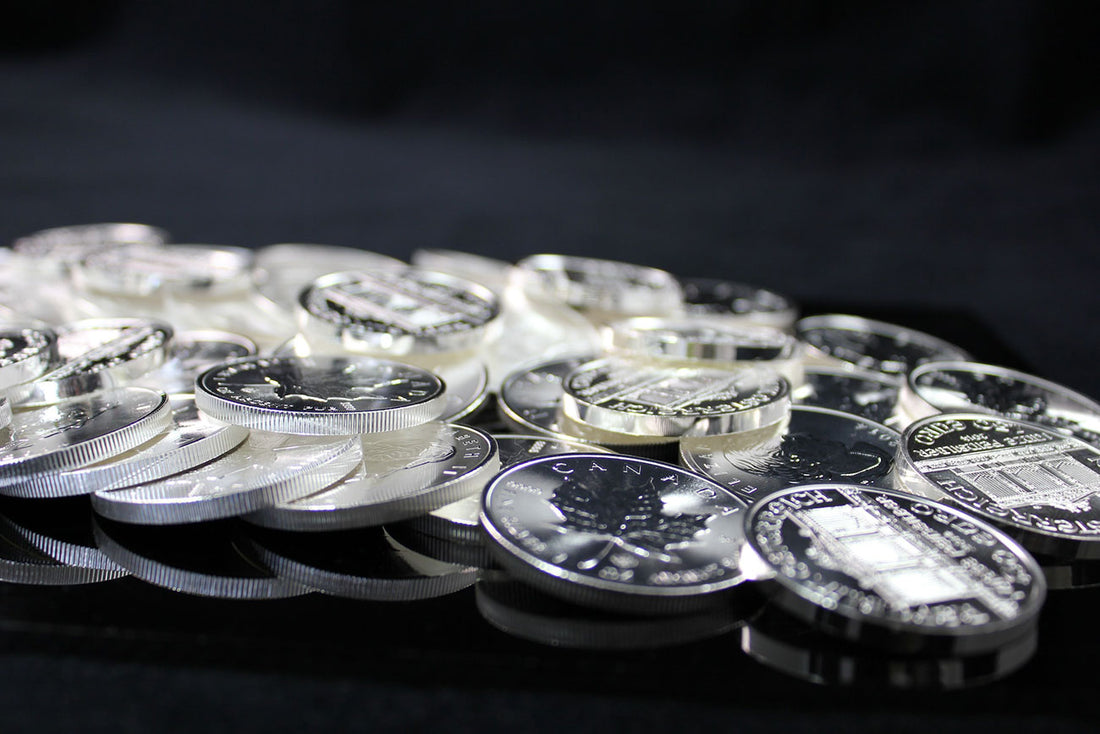Bullion investors know that precious metals provide an effective avenue for diversifying your portfolio. Precious metals expose you to a diverse set of risks, and they can help protect part of your portfolio from the market crashes and volatility that often affect stock markets.
Gold and silver are good places to start, but could you be doing more? Smart investors are always on the lookout for ways to improve their portfolios and new opportunities for growth. Even if you’ve never considered it before, now may be the time to take a deeper look at investing in platinum bullion bars or coins.
What Is Platinum?
Platinum is a chemical element that occurs in nature, just like gold and silver. It’s mined from the earth’s crust, and 80% of the world’s deposits are found in South Africa and Canada (specifically, the Sudbury Basin), with smaller deposits found in the U.S., Australia, and Zimbabwe. It is a silvery-white metal that is often used in jewellery, dentistry, and the automotive industry. Platinum is also one of the most valuable precious metals in the world.
Just like gold and silver, you can buy platinum bullion that is made for investors and easily exchanged. Thanks to these similarities, it should feel very familiar to bullion investors, though its market dynamics give it some unique risks and opportunities that can be worth including in your portfolio.
Platinum Bullion Prices
If you’re familiar with music sales, you’ve likely heard of an album “going platinum,” meaning that an album has sold more than 1 million units. That compares to a gold record, which only requires 500,000 units.
It’s a popular turn of phrase that leads many people to believe that platinum is worth even more than gold. There are times when that assumption is correct, but there are also times, such as now, when this is not the case.
Platinum got its reputation for higher prices during the long stretch between 1987 and 2011 when prices were higher than gold. After that period, platinum prices fell dramatically, while gold provided more stability. Gold prices have typically exceeded platinum prices for the last decade-plus. Determining the price of bullion is always an important step before you invest, and you should know how your metal of choice compares to other bullion products.
We’ll look more closely at the dynamic between gold and platinum further down to see why this happened and how investors can take advantage of the relationship between these two precious metals.
Why You Should Include Platinum Bullion in Your Portfolio
Platinum offers many of the same advantages to your portfolio that other precious metals can provide, as well as some unique properties that make it worth exploring. Some of the benefits of investing in platinum include:
- Using it as a hedge against inflation.
- Diversifying your portfolio out of stock market risks.
- Preserving wealth over decades or even generations.
- Capitalizing on growth in demand for jewellery, electronics, and automobiles.
- Taking advantage of a low correlation with stocks and bonds.
These benefits should sound familiar to most bullion investors. The value that platinum adds is an even greater degree of scarcity, with only about 190 metric tons mined annually. Platinum prices are also driven more by industrial demand, which can help prices during times of high commodity prices and strong consumer demand.
The next time you’re rebalancing your portfolio, consider making room for platinum if you’re looking for a strong defensive asset that will help you mitigate the risks of investing in equities.

How to Buy Platinum Bullion in Canada
There are several ways you can include platinum in your portfolio in Canada.
Platinum ETFs
Exchange-Traded Funds are a popular way to invest in precious metals on paper. ETFs allow you to buy shares in a fund that trades in platinum with the goal of matching the metal’s performance, but you don’t own any. Keep in mind that ETFs charge expense ratios to pay for managing the fund, and that can eat into the performance of an asset that does not provide interest or dividends.
Platinum Stocks
While you can’t buy stocks in the metal itself, you can buy stocks in mining companies or other companies that process or use platinum. These are often important components of ETFs as well. Platinum stocks aren’t quite as common as gold stocks, and many mining companies put their primary focus on other metals. The performance of mining companies also hinges as much (if not more) on management than the metal itself, and rising metal prices are no guarantee of stock performance.
Physical Platinum Bullion
One of the most reliable and straightforward ways to invest in precious metals is to buy the product itself. Platinum is commonly available in bars, coins, rounds, and ingots, as well as some items, like rare coins, that may have additional collectible value. You will have to consider a strategy for storing physical platinum, but it remains one of the best ways to reduce external risks and enjoy the full advantages of bullion ownership.
As your best source for bullion, Global Bullion Suppliers is committed to providing high-quality bullion products at great prices. One of our top selling bullion products is the 1 oz. Platinum Royal Britannia Coin, .9995 platinum coin made by the Royal Mint in the United Kingdom.
What You Need to Know About Investing in Platinum Bullion
The more information you have as an investor, the better you’ll be at making smart decisions. These are some of the top factors that every investor should consider before investing in platinum. You can also speak to a bullion dealer about the ins and outs of bullion investing. It’s a great idea if you’re a beginner and you want to know more about optimizing your investments.
#1 Market Factors
There are too many factors that go into financial markets for one investor to be on top of them all. Even experts can’t accurately predict where the price of any single asset will go. However, it does help if you know the basics of how platinum markets work.
There are three primary factors that influence the price of platinum, and they may complement or work at odds with each other:
- The strength of industries that drive demand for platinum, including jewellery, electronics, and automotive.
- Investor sentiment toward geopolitical risk, inflation, stock markets, and the U.S. dollar.
- Supply-side conditions, such as the cost of mining new platinum and the discovery of new deposits.
#2 Costs
There are also costs to owning bullion that you will have to consider. When you buy physical bullion, the primary costs will be storage and insurance. You have several storage options that may fit depending on your preference, including:
- Buying a home safe or another secure storage option that you can keep at home.
- Keeping your bullion in a safe deposit box at a bank.
- Third-party vault storage, which may be allocated or non-allocated.
Third-party storage usually comes with insurance included in the costs. If you’re storing bullion at home, check out your home insurance policy. You may need additional coverage to protect a large investment in bullion.

#3 Taxes
Bullion in Canada, including platinum, is treated like other financial vehicles. This means that when you buy platinum coins and bars, you generally do not pay GST/HST. Instead, you may have to pay capital gains taxes when you turn around and sell platinum bullion. There are different rules for capital gains taxes depending on where you live, so make sure you’re up to speed on the details.
#4 Risk Management
Investing in bullion is an effective way to manage risks in your portfolio through diversification. As a rule of thumb, most portfolios can dedicate anywhere from 5% to 10% to precious metals, and it may make sense to spread this allocation between different metals.
Platinum vs Gold Bullion: Which One Should You Buy?
Platinum and gold are both valuable precious metals that can play important but unique roles in your portfolio. The two metals have some different investment characteristics that can make it worth diversifying your precious metals allocation between them.
The main difference between the two is that gold tends to offer more stability, while platinum can be more volatile. Investors remain the primary driver of gold prices, while industrial demand significantly impacts platinum.
How does this difference manifest? There are many ways this can play out, but in general, a strong economy typically means that there are better investments than gold available because stock markets are climbing. A strong global economy also means that consumer demand is rising, and products like jewellery, electronics, and automobiles (all of which use platinum) are in demand.
A strong economy can benefit platinum prices in ways that might punish gold prices. Investors love gold during recessions, geopolitical crises, and times of high inflation. Platinum can also benefit from increased consumer demand toward precious metals as a whole, but as a rule, platinum demands reliance on industrial usage, which tends to make it more volatile, while gold offers more stability.
Ultimately, gold and platinum prices tend to move in the same direction over the long term. They may diverge in the short term, and the potential for platinum to retake its position as the more valuable metal offers investors a promising opportunity.
Platinum vs Silver Bullion
In many ways, platinum functions like a more valuable version of silver. Silver is also influenced strongly by industrial demand, and the two metals are used in many of the same industries.
Depending on the amount of money you’re investing, platinum may be a more cost-effective way to invest in a precious metal with more volatility and industrial demand than gold. The premiums on silver tend to eat up a significant percentage of your investment, and the lower cost means you can quickly run into higher storage costs. The higher value of platinum gives you a more compact asset.
Don’t neglect platinum if you’re a bullion investor. The metal can provide a special opportunity and further diversification in your portfolio.

